Self-Assessment Framework for Corporate Environmental Sustainability in the Era of Digitalization
Abstract
:1. Introduction
2. The Interlinkage of Environmental Sustainability, Business Transformation, and Digitalization
2.1. Environmental Sustainability
2.2. Business Transformation towards ES
2.3. The Role of Digitalization
2.4. Synthesis of the Self-Assessment Framework
3. State-of-the-Art
- Integrate the view on ES and digitalization based on the design principles;
- Consider all defined business views;
- Address all defined business transformation enablers;
- Apply a qualitative and quantitative assessment approach.
4. Assessment Framework
4.1. Framework Design
4.1.1. Dimensions
4.1.2. Maturity Levels
4.1.3. Indicators
4.2. Framework Application
5. Evaluation Results
5.1. Expert Evaluation
5.2. Use Case
5.3. Discussion
5.3.1. Discussion on the Integrated Consideration of Sustainability and Digitalization
5.3.2. Discussion of the Results
6. Conclusions
- Development of a self-assessment tool that closes the existing gap in maturity models between ES and digitalization;
- Development of six aligned maturity models that provide a holistic view of CES based on our defined business perspective and the ES design principles;
- Development of a novel modular sustainability assessment framework with a rapid and full assessment to enable companies to start with low resources and explore their businesses;
- Provide an evaluated and promising approach to support companies in their transformation towards environmentally sustainable business.
7. Limitations and Future Work
Author Contributions
Funding
Institutional Review Board Statement
Informed Consent Statement
Data Availability Statement
Conflicts of Interest
Appendix A
| ID | Business Domains | Definition |
|---|---|---|
| 1 | Business strategy | The starting point of business transformation is characterized by the corporate policy structure and its long-term orientation. |
| 2 | Information systems | This level supports processes via “computerized information processing”. |
| 3 | Process | This level executes the defined policy in different fields of activity. |
| Sub-Domain | Definition |
|---|---|
| Management responsibility | explores the management’s responsibility for sustainability issues. |
| Target setting | explores the targets and strategies for sustainability issues |
| Compliance | explores the regulations or standards the company complies with. |
| Competencebuilding | explores the competence building for sustainability within the company. |
| Data measurement | explores what method of data collection is related to the data’s level of detail |
| Data processing | explore how the data are processed and used |
| Maturity Level | Maturity Name | Description |
|---|---|---|
| 0 | Initial | The company meets the minimal requirements to remain compliant or perform business as usual. |
| 1 | Rudimentary | The company undertakes additional efforts to overcome business as usual. Analysis and measures that do not follow any specified corporate strategy lead to the “discovery” of potential enhancements. |
| 2 | Elementary | The company initiates the first measures and formulates a corporate strategy regarding environmental sustainability. Then, additional analysis methods are used to systematically understand hot spots and reduction targets are set. |
| 3 | Industry average | The company initiates a learning and improvement process based on corporate environmental sustainability. The life cycle perspective is an essential consideration in decision-making. Results from analysis and measures drive the integration of environmental sustainability as a core business element. |
| 4 | Outstanding | The company drives the holistic integration of environmental sustainability across the whole company and can positively impact environmental, economic, and social aspects. Based on the life cycle perspective, the first collaboration programs with suppliers and partners are initiated to move towards environmentally beneficial innovations. |
| 5 | Visionary | The company adapts visionary concepts to reduce unsustainability and create sustainability (circularity flows). The measures lead to environmentally beneficial innovations that positively impact the environment, society, and business partners. |
| Evaluation Criteria | Definition | Questions on a Likert Scale of 1 to 5, with 1 Being “Strongly Disagree” and 5 Being “Strongly Agree” |
|---|---|---|
| Sufficiency | The sufficiency aspect comprises two criteria: 1. The sufficiency of maturity levels in the MM for representing all possible maturation levels of the sub-domain; 2. The sufficiency of the maturity levels for describing the performance of a company.The rationale for the former criterion is to ensure that the maturity levels are sufficient in covering or representing all possible maturation levels of a company so that any company that attempts the assessment framework will be able to use a maturity level to describe itself. The rationale for the latter criterion is that the maturity levels have to be holistic and consider how all possible policies, pathways, or activities that a company may engage in evolving as the company moves up in the MM. The maturation of a company should be reflected by its improvements in the relevant policies, pathways, or activities, making it necessary to check that all steps for improvements in the policies, pathways, or activities have been accounted for in the maturity levels. This criterion also ensures that there is no measurable or describable improvement below or beyond the first and final maturity level. |
|
| Distinctness | The criterion of distinctness refers to the maturity levels being distinct and the differences between the maturity levels being clear. The rationale for this is to allow companies to be able to easily select one maturity level that best describes them. Reviewers are asked one question, and those who rated the MM poorly on the above aspect are then encouraged to answer a further question. |
|
| Usefulness | The aspect of usefulness comprises three criteria. The first criterion is the extent to which the maturity levels measure a company’s performance in the relevant sub-domain, for which it is necessary to convert a qualitative description of a company into a quantifiable measurement, which can later be used for scoring or comparative purposes. The second criterion checks whether the maturity levels are useful in helping a company to identify how it can improve. This means that a company should be able to look to the next maturity level to give it a general idea as to the policies, pathways, or activities it can implement or follow to become more sustainable. The last criterion is whether the maturity level is practical, informative, and useful for companies. This is necessary to ensure that the policies, pathways, and activities used in the maturity model are representative of those implemented in the industry. Likewise, a company of lower maturity that reads the maturity levels will be able to learn about the policies, pathways, and activities that are implemented in the industry by more mature companies and make targeted improvement steps towards sustainability. |
|
| ||
| ||
| Ease of use | The criterion ease of use refers to the extent to which a company will be able to identify which maturity level they have achieved. This criterion is used to ensure that the descriptions for each maturity level are easy to read and understandable to both the managers and technical personnel, who are the target audience of the assessment framework. Reviewers are asked one question, and those who rate the MM poorly on the above criterion are encouraged to answer one further question. |
|
| Accuracy | This criterion refers to the accuracy with which policies, pathways, and activities, which the company sees as their processes and practices, are correctly assigned to suitable and relevant maturity levels. This means that processes and practices are assigned to maturity levels based on how complicated there are and that there are no mismatched processes and practices that result in a maturity level being too easy or difficult to attain in a manner that is disproportionate to the MM. Reviewers are asked one question, and those who rate the MM poorly on the above criterion are encouraged to answer one further question. |
|
| Evaluation Criteria | Questions on a Likert Scale of 1 to 5, with 1 Being “Strongly Disagree” and 5 Being “Strongly Agree” |
| Understandability |
|
| Ease of use |
|
| Usefulness |
|
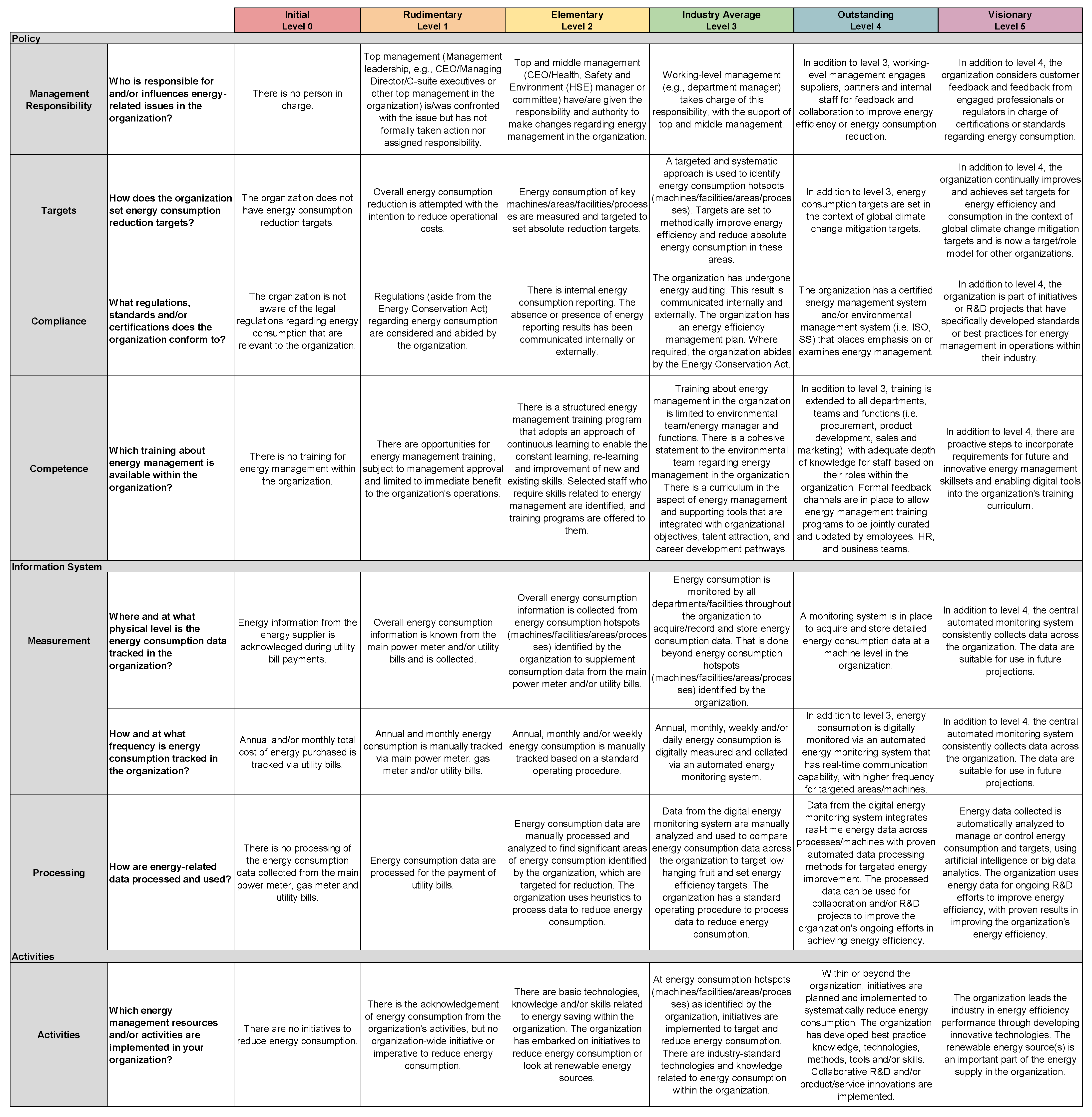
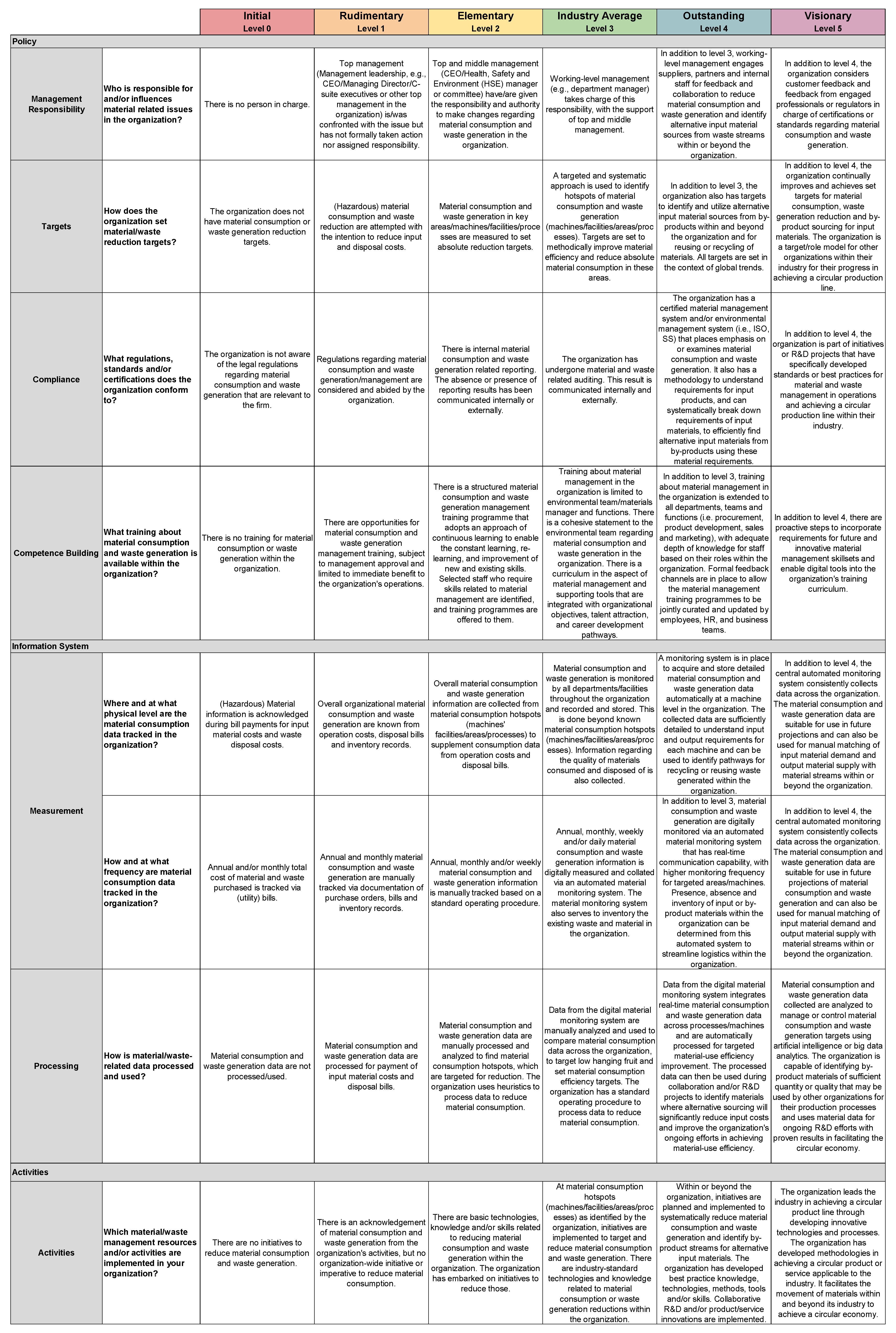
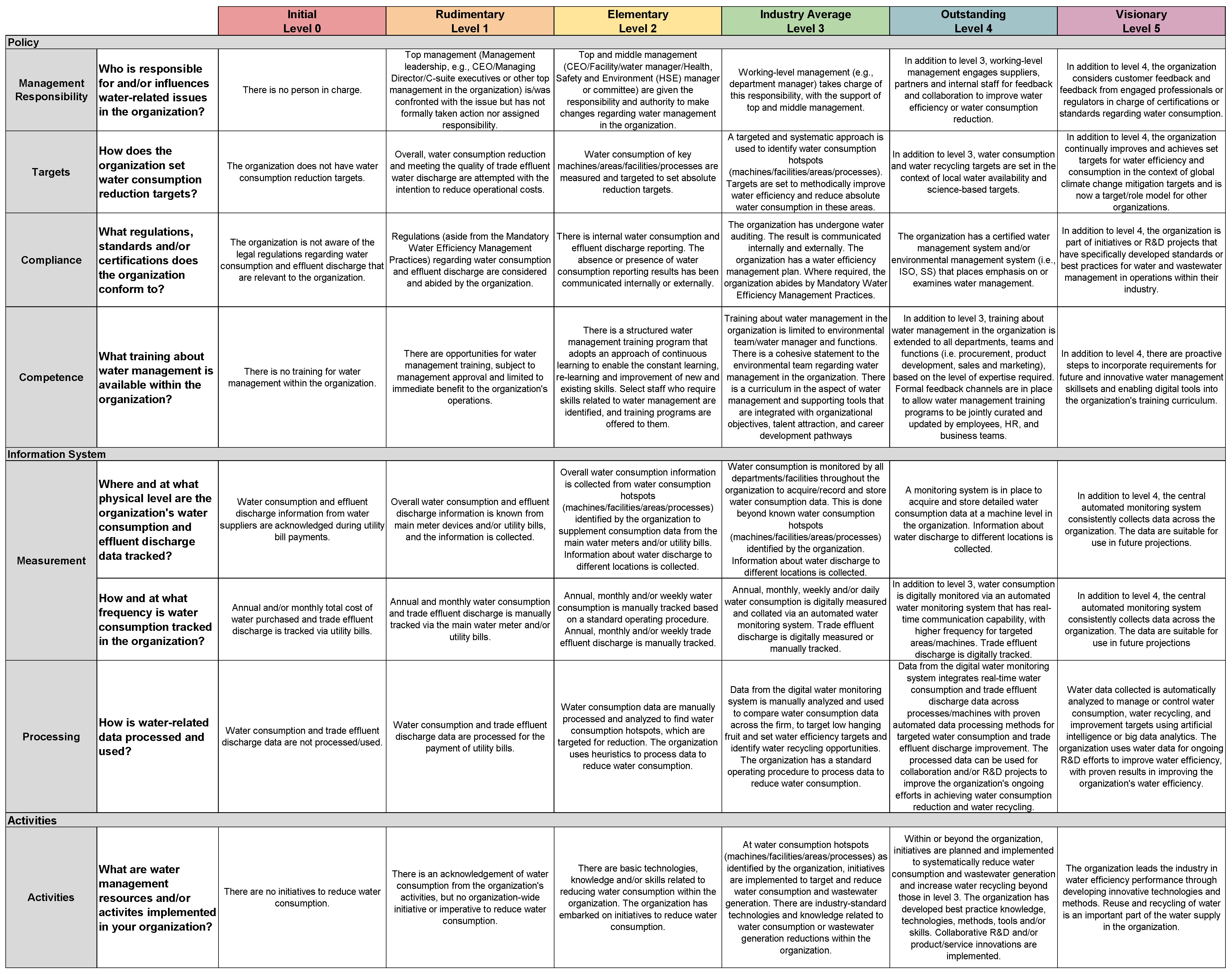

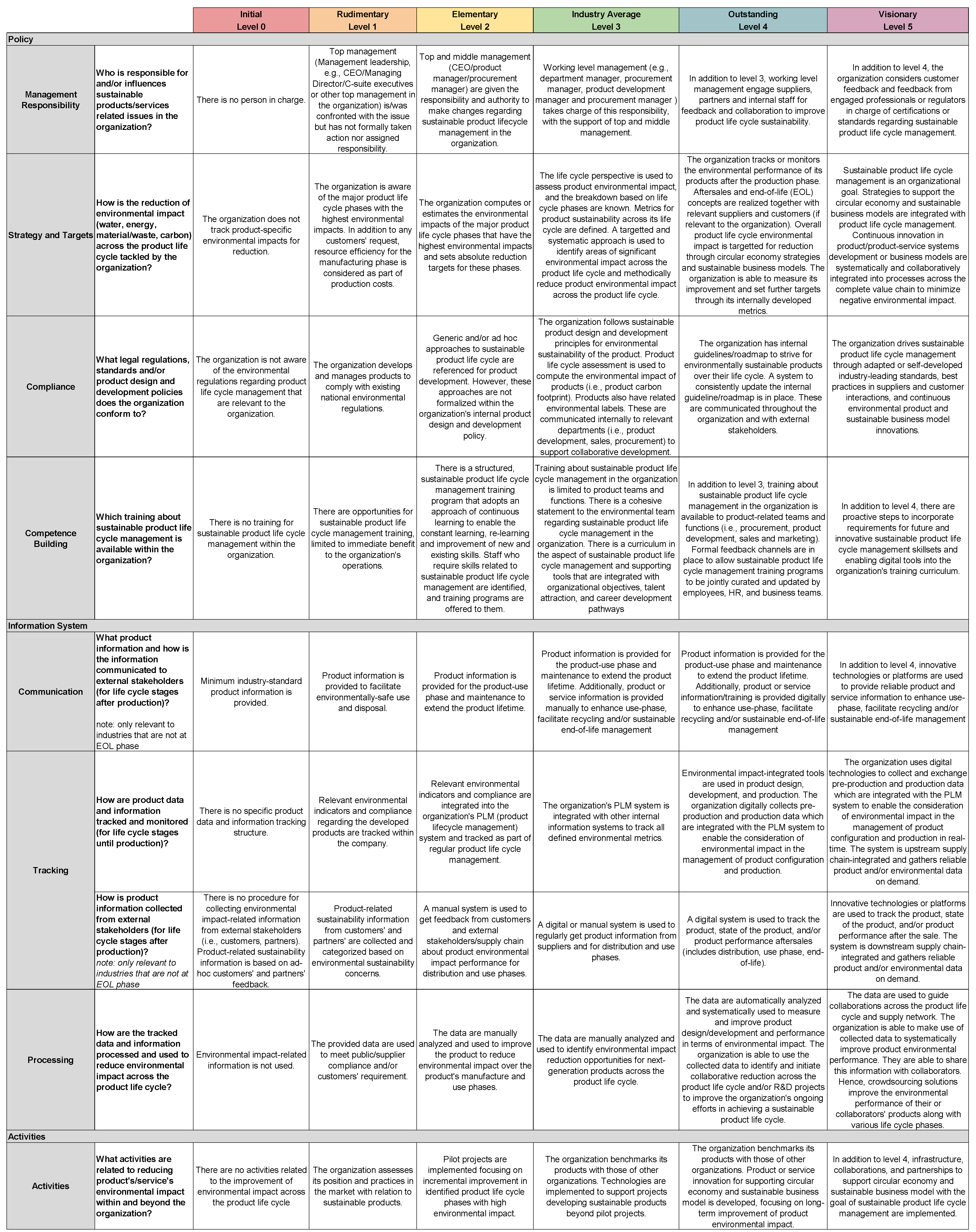
References
- European Commission. The European Green Deal. Eur. Comm. 2019, 53, 24. [Google Scholar] [CrossRef]
- Galvin, R.; Healy, N. The Green New Deal in the United States: What it is and how to pay for it. Energy Res. Soc. Sci. 2020, 67, 101529 . [Google Scholar] [CrossRef]
- Holzmann, A.; Grünberg, N. ‘Greening’ China: An Analysis of Beijing’s Sustainable Development Strategies. 2021. Available online: https://merics.org/en/report/greening-china-analysis-beijings-sustainable-development-strategies (accessed on 27 January 2021).
- Ministry of Education Singapore; Ministry of National Development Singapore; Ministry of Sustainability and the Environment Singapore; Ministry of Trade and Industry Singapore; Ministry of Transport Singapore. Singapore Green Plan 2030. 2021. Available online: https://www.greenplan.gov.sg/ (accessed on 23 July 2021).
- European Comission. Questions and Answers: Corporate Sustainability Reporting Directive Proposal. 2021. Available online: https://ec.europa.eu/commission/presscorner/detail/en/qanda_21_1806 (accessed on 2 August 2021).
- Metz, P.; Burek, S.; Hultgren, T.R.; Kogan, S.; Schwartz, L. The Path to Sustainability-Driven Innovation. Res. Technol. Manag. 2016, 59, 50–61. [Google Scholar] [CrossRef]
- Dale, B.; Williams, R.; Kolb, F.; Luzon, D.M.; Wallace, M. State-of-the-art study on self-assessment. TQM Mag. 1995, 7, 13–17. [Google Scholar]
- Lee, J.; Akkiraju, R.; Tian, C.H.; Jiang, S.; Danturthy, S.; Sundhararajan, P.; Nordman, C.; Mohan, R.; Singala, H.; Ding, W. Business Transformation Workbench: A Practitioner′s Tool for Business Transformation. In Proceedings of the IEEE International Conference on Services Computing, Honolulu, HI, USA, 7–11 July 2008; Volume 2, pp. 81–88. [Google Scholar] [CrossRef] [Green Version]
- Österle, H. Business in the Information Age; Springer: Berlin/Heidelberg, Germany, 1995. [Google Scholar] [CrossRef]
- Berkhout, F.; Hertin, J. Impacts of Information and Communication Technologies on Environmental Sustainability: Speculations and Evidence; University of Sussex: Brighton, UK, 2001; Available online: https://www.oecd.org/sti/inno/1897156.pdf (accessed on 3 September 2021).
- Chen, X.; Despeisse, M.; Johansson, B. Environmental sustainability of digitalization in manufacturing: A. review. Sustainbility 2020, 12, 10298. [Google Scholar] [CrossRef]
- Berkhout, F.; Hertin, J. De-materialising and re-materialising: Digital technologies and the environment. Futures 2004, 36, 903–920. [Google Scholar] [CrossRef]
- Oláh, J.; Aburumman, N.; Popp, J.; Khan, M.A.; Haddad, H.; Kitukutha, N. Impact of Industry 4.0 on Environmental Sustainability. Sustainability 2020, 12, 4674. [Google Scholar] [CrossRef]
- De Sousa Jabbour, A.B.L.; Jabbour, C.J.C.; Foropon, C.; Godinho Filho, M. When titans meet—Can industry 4.0 revolutionise the environmentally-sustainable manufacturing wave? The role of critical success factors. Technol. Forecast. Soc. Chang. 2018, 132, 18–25. [Google Scholar] [CrossRef]
- Plattform Industrie 4.0. Sustainable Production: Actively Shaping the Ecological Transformation with Industrie 4.0. 2021. Available online: https://www.plattform-i40.de/IP/Redaktion/DE/Downloads/Publikation/Nachhaltige-Produktion.html (accessed on 3 April 2021).
- Schebek, L.; Kannengieβer, J.; Campitelli, A. Ressourceneffizienz durch Industrie 4.0—Potenziale für KMU des verarbeitenden Gewerbes. 2017, p. 183. Available online: http://www.ressource-deutschland.de/fileadmin/Redaktion/Bilder/Newsroom/Studie_Ressourceneffizienz_durch_Industrie_4.0.pdf (accessed on 6 September 2021).
- George, R.A.; Siti-Nabiha, A.; Jalaludin, D.; Abdalla, Y.A. Barriers to and enablers of sustainability integration in the performance management systems of an oil and gas company. J. Clean. Prod. 2016, 136, 197–212. [Google Scholar] [CrossRef]
- Steinhöfel, E.; Galeitzke, M.; Kohl, H.; Orth, R. Sustainability Reporting in German Manufacturing SMEs. Procedia Manuf. 2019, 33, 610–617. [Google Scholar] [CrossRef]
- Siegel, R.; Antony, J.; Garza-Reyes, J.A.; Cherrafi, A.; Lameijer, B. Integrated green lean approach and sustainability for SMEs: From literature review to a conceptual framework. J. Clean. Prod. 2019, 240, 118205. [Google Scholar] [CrossRef]
- Caldera, H.; Desha, C.; Dawes, L. Evaluating the enablers and barriers for successful implementation of sustainable business practice in ‘lean’ SMEs. J. Clean. Prod. 2019, 218, 575–590. [Google Scholar] [CrossRef]
- Kiel, D.; Müller, J.M.; Arnold, C.; Voigt, K.I. Sustainable industrial value creation: Benefits and challenges of industry 4.0. Digit. Disruptive Innov. 2017, 21, 1740015. [Google Scholar] [CrossRef]
- Jones, M.D.; Hutcheson, S.; Camba, J.D. Past, present, and future barriers to digital transformation in manufacturing: A review. J. Manuf. Syst. 2021, 60, 936–948. [Google Scholar] [CrossRef]
- Isensee, C.; Teuteberg, F.; Griese, K.-M.; Topi, C. The relationship between organizational culture, sustainability, and digitalization in SMEs: A systematic review. J. Clean. Prod. 2020, 275, 122944. [Google Scholar] [CrossRef]
- Gupta, S.; Motlagh, M.; Rhyner, J. The Digitalization Sustainability Matrix: A Participatory Research Tool for Investigating Digitainability. Sustainability 2020, 12, 9283. [Google Scholar] [CrossRef]
- Gregor, S. Building theory in the sciences of the artificial. In Proceedings of the 4th International Conference on Design Science Research in Information Systems and Technology, Worcester, MA, USA, 4–6 June 2009; p. 4. [Google Scholar]
- World Commission on Environment and Development. Our Common Future; Oxford University Press: Oxford, UK, 1987; Volume 14. [Google Scholar] [CrossRef]
- Steurer, R. Paradigmen der Nachhaltigkeit. Z. Für Umweltpolit. Umweltr. 2001, 4, 537–566. [Google Scholar]
- Shrivastava, P. The Role of Corporations in Achieving Ecological Sustainability. Acad. Manag. Rev. 1995, 20, 936–960. [Google Scholar] [CrossRef]
- Sharma, S.; Henriques, I.; Sharma, S. Stakeholder influences on sustainability practices in the Canadian forest products industry. Strateg. Manag. J. 2005, 26, 159–180. [Google Scholar] [CrossRef]
- Gladwin, T.N.; Kennelly, J.J.; Krause, T. Shifting Paradigms for Sustainable for Implications Development And Theory. Acad. Manag. Rev. 1995, 20, 874–907. [Google Scholar] [CrossRef]
- Bansal, P. Evolving sustainably: A longitudinal study of corporate sustainable development. Strat. Manag. J. 2005, 26, 197–218. [Google Scholar] [CrossRef]
- Elkington, J. Cannibals with Forks The Triple Bottom Line of 21st Century Business; Capstone Publishing Ltd.: Oxford, UK, 1997; ISBN 1-900961-27-X. [Google Scholar]
- Hauschild, M.Z.; Kara, S.; Røpke, I. Absolute sustainability: Challenges to life cycle engineering. CIRP Ann. 2020, 69, 533–553. [Google Scholar] [CrossRef]
- GreenBiz Group and Black & Veatch. Corporate Sustainability Goal Setting and Measurement; GreenBiz: Oakland, CA, USA, 2021. [Google Scholar]
- Clean Energy Wire. Germany’s Carbon Pricing System for Transport and Buildings. 2020. Available online: https://www.cleanenergywire.org/factsheets/germanys-planned-carbon-pricing-system-transport-and-buildings (accessed on 28 July 2021).
- McKinsey & Company. The Next Normal Reimagining Operational Resilience Building Future-proof Strategies. 2021. Available online: https://www.mckinsey.com/~/media/mckinsey/business%20functions/operations/our%20insights/the%20need%20for%20resiliency/reimagining-operational-resilience-vf.pdf. (accessed on 2 February 2021).
- Porter, M.E. Competitive Advantage Creating and Sustaining Superior Performance, First Free Press Edition 1985; Free Press: New York, NY, USA, 1998; ISBN 0-684-84146-0. [Google Scholar]
- Müller, A.-L.; Pfleger, R. Business transformation towards sustainability. Bus. Res. 2014, 7, 313–350. [Google Scholar] [CrossRef] [Green Version]
- CERES. The CERES Roadmap for Sustainability. 2018. Available online: https://www.ceres.org/sites/default/files/2018-02/ceres-rfs-8.5x11-rd7-v1-1-sm_updated.pdf. (accessed on 5 January 2021).
- Kiron, D.; Unruh, G.; Kruschwitz, N.; Reeves, M.; Rubel, H.; Meyer zum Felde, A. Corporate Sustainability at a Crossroads—Progress toward our common Future in Uncertain Times. 2017. Available online: https://sloanreview.mit.edu/projects/corporate-sustainability-at-a-crossroads/ (accessed on 3 March 2021).
- GRI. Gri 101: Foundation 2016 101. GRI Stand. 2016, GRI 101, 29. Available online: www.globalreporting.org (accessed on 2 May 2021).
- Feroz, A.K.; Zo, H.; Chiravuri, A. Digital Transformation and Environmental Sustainability: A Review and Research Agenda. Sustainability 2021, 13, 1530. [Google Scholar] [CrossRef]
- Paavola, R.; Hallikainen, P.; Elbanna, A. Role of middle managers in modular digital transformation: The case of Servu. In Proceedings of the 25th European Conference on Information Systems, ECIS 2017, Guimarares, Portugal, 5–10 June 2017; Volume 2017, pp. 887–903. [Google Scholar]
- Morakanyane, R.; Grace, A.; O’Reilly, P. Conceptualizing digital transformation in business organizations: A systematic review of literature. In Proceedings of the 30th Bled eConference Digital Transformation – From Connecting Things to Transforming Our Lives, BLED 2017, Bled, Slovenia, 18–21 June 2017; pp. 427–444. [Google Scholar] [CrossRef] [Green Version]
- Li, L.; Su, F.; Zhang, W.; Mao, J.-Y. Digital transformation by SME entrepreneurs: A capability perspective. Inf. Syst. J. 2018, 28, 1129–1157. [Google Scholar] [CrossRef]
- Legner, C.; Eymann, T.; Hess, T.; Matt, C.; Böhmann, T.; Drews, P.; Mädche, A.; Urbach, N.; Ahlemann, F. Digitalization: Opportunity and Challenge for the Business and Information Systems Engineering Community. Bus. Inf. Syst. Eng. 2017, 59, 301–308. [Google Scholar] [CrossRef]
- Vial, G. Understanding digital transformation: A review and a research agenda. J. Strateg. Inf. Syst. 2019, 28, 118–144. [Google Scholar] [CrossRef]
- Economy 2017. Available online: https://www.bmwi.de/Redaktion/EN/Publikationen/monitoring-report-wirtschaft-digital-2017.html (accessed on 14 December 2021).
- Tilson, D.; Lyytinen, K.; Sørensen, C. Research Commentary—Digital Infrastructures: The Missing IS Research Agenda. Inf. Syst. Res. 2010, 21, 748–759. [Google Scholar] [CrossRef]
- Santos, J.; Muñoz-Villamizar, A.; Ormazábal, M.; Viles, E. Using problem-oriented monitoring to simultaneously improve productivity and environmental performance in manufacturing companies. Int. J. Comput. Integr. Manuf. 2019, 32, 183–193. [Google Scholar] [CrossRef]
- Nascimento, D.L.M.; Alencastro, V.; Quelhas, O.L.G.; Caiado, R.G.G.; Garza-Reyes, J.A.; Rocha-Lona, L.; Tortorella, G. Exploring Industry 4.0 technologies to enable circular economy practices in a manufacturing context: A business model proposa. J. Manuf. Technol. Manag. 2019, 30, 607–627. [Google Scholar] [CrossRef]
- Gajšek, B.; Sternad, M. Information Flow in the Context of the Green Concept, Industry 4.0, and Supply Chain Integration; Springer International Publishing: New York, NY, USA, 2020. [Google Scholar] [CrossRef]
- Gilchrist, A. Industry 4.0; Apress: Berkeley, CA, USA, 2016; Volume 33. [Google Scholar] [CrossRef]
- Ghobakhloo, M. The future of manufacturing industry: A strategic roadmap toward Industry 4.0. J. Manuf. Technol. Manag. 2018, 29, 910–936. [Google Scholar] [CrossRef] [Green Version]
- Song, Z.; Moon, Y. Assessing sustainability benefits of cybermanufacturing systems. Int. J. Adv. Manuf. Technol. 2016, 90, 1365–1382. [Google Scholar] [CrossRef]
- Thiede, S. Environmental Sustainability of Cyber Physical Production Systems. Procedia CIRP 2018, 69, 644–649. [Google Scholar] [CrossRef]
- Dröder, K.; Vietor, T. Technologies for Economical and Functional Lightweight Design; Springer: New York, NY, USA, 2018. [Google Scholar]
- Baheti, R.; Gill, H. Cyber-physical Systems. Impact Control Technol. 2011, 12, 161–166. [Google Scholar]
- Ghobakhloo, M. Industry 4.0, digitization, and opportunities for sustainability. J. Clean. Prod. 2019, 252, 119869. [Google Scholar] [CrossRef]
- Tsolakis, N.; Harrington, T.S.; Srai, J.S. The Management of Operations Digital supply network design: A Circular Economy challenges. Prod. Plan. Control 2021, 1–26. [Google Scholar] [CrossRef]
- Lee, J. Industrial AI; Springer: Singapore, 2020. [Google Scholar] [CrossRef]
- Junior, J.A.G.; Busso, C.M.; Gobbo, S.C.O.; Carreão, H. Making the links among environmental protection, process safety, and industry 4.0. Process. Saf. Environ. Prot. 2018, 117, 372–382. [Google Scholar] [CrossRef] [Green Version]
- Hilty, L.M. ICT for Sustainability: An Emerging Research Field; Springer: Cham, Switzerland, 2017. [Google Scholar] [CrossRef]
- Van Der Velden, M. Digitalisation and the UN Sustainable development Goals: What role for design. IDA Interact. Des. Archit. 2018, 37, 160–174. [Google Scholar]
- Hynds, E.J.; Brandt, V.; Burek, S.; Knox, P.; Parker, J.P.; Zietlow, M.; Schwartz, L.; Taylor, J.; Jager, W. A Maturity Model for Sustainability in New Product Development. Res. Technol. Manag. 2014, 57, 50–57. [Google Scholar] [CrossRef] [Green Version]
- Schonherr, N.; Martinuzzi, A. Business and the Sustainable Development Goals: Measuring and Managing Corporate Impacts; Springer: New York, NY, USA, 2019. [Google Scholar]
- Pigosso, D.C.; Rozenfeld, H.; McAloone, T.C. Ecodesign maturity model: A management framework to support ecodesign implementation into manufacturing companies. J. Clean. Prod. 2013, 59, 160–173. [Google Scholar] [CrossRef] [Green Version]
- Baumgartner, R.J.; Ebner, D. Corporate sustainability strategies: Sustainability profiles and maturity levels. Sustain. Dev. 2010, 18, 76–89. [Google Scholar] [CrossRef]
- Cagnin, C.H.; Loveridge, D.; Butler, J. Business Sustainability Maturity Model. Comput. Comun. Rev. 2013, 1–15. [Google Scholar] [CrossRef]
- Golinska, P.; Kuebler, F. The Method for Assessment of the Sustainability Maturity in Remanufacturing Companies. Procedia CIRP 2014, 15, 201–206. [Google Scholar] [CrossRef]
- Finnerty, N.; Sterling, R.; Coakley, D.; Keane, M. An energy management maturity model for multi-site industrial organisations with a global presence. J. Clean. Prod. 2017, 167, 1232–1250. [Google Scholar] [CrossRef] [Green Version]
- Reefke, H.; Ahmed, M.D.; Sundaram, D. Sustainable Supply Chain Management—Decision Making and Support: The SSCM Maturity Model and System. Glob. Bus. Rev. 2014, 15, S1–S12. [Google Scholar] [CrossRef] [Green Version]
- Schuh, G.; Anderl, R.; Gausemeier, J.; Hompel ten, M.; Wahlster, W. Industry 4.0 maturity index. Assembly 2018, 61, 32–35. [Google Scholar]
- Lichtblau, K.; Stich, V.; Bertenrath, R.; Blum, M.; Bleider, M.; Millack, A.; Schmitt, K.; Schmitz, E. MPULS—Industrie 4.0 Readiness. 2015. Available online: https://www.semanticscholar.org/paper/Industrie-4.0-Readiness-Lichtblau-Bertenrath/fb4ee757dd678b8126eaa33114dcea82ae8c77bb (accessed on 14 December 2021).
- EDB Singapore. The Singapore Smart Industry Readiness Index. 2018; p. 46. Available online: https://speta.org/wp-content/uploads/2019/08/SIRI-White-Paper.pdf (accessed on 23 August 2021).
- Geissbauer, R.; Vedso, J.; Schrauf, S. Industry 4.0: Building the Digital Enterprise. 2016. Available online: www.pwc.com/industry40 (accessed on 23 August 2021).
- Termer, F. Reifegradmodell zum Digital Analytics & Optimization Maturity Index (DAOMI). 2018, pp. 1–75. Available online: www.bitkom.org (accessed on 23 August 2021).
- Netland, T.; Alfnes, E. Proposing a quick best practice maturity test for supply chain operations. Meas. Bus. Excel. 2011, 15, 66–76. [Google Scholar] [CrossRef] [Green Version]
- Neff, A.A.; Hamel, F.; Herz, T.P.; Uebernickel, F.; Brenner, W.; Brocke, J.V. Developing a maturity model for service systems in heavy equipment manufacturing enterprises. Inf. Manag. 2014, 51, 895–911. [Google Scholar] [CrossRef]
- Becker, J.; Knackstedt, R.; Pöppelbuß, D.-W.I.J. Developing Maturity Models for IT Management. Bus. Inf. Syst. Eng. 2009, 1, 213–222. [Google Scholar] [CrossRef]
- Salah, D.; Paige, R.; Cairns, R. An Evaluation Template for Expert Review of Maturity Models. In Proceedings of the 15th International Conference, PROFES 2014, Helsinki, Finland, 10–12 December 2014; pp. 318–321. [Google Scholar]
- Fraser, P.; Moultrie, J.; Gregory, M. The use of maturity models/grids as a tool in assessing product development capability. In Proceedings of the IEEE International Engineering Management Conference, Cambridge, UK, 18–20 August 2002; Volume 1, pp. 244–249. [Google Scholar] [CrossRef]
- Johnson, M. Integrating the Supply Chain... 25 years on. Int. J. Phys. Distrib. Mater. Manag. 2018. [Google Scholar] [CrossRef] [Green Version]
- Global Reporting Initiative. GRI Standards. Available online: https://www.globalreporting.org/standards/gri-standards-download-center/ (accessed on 17 September 2020).
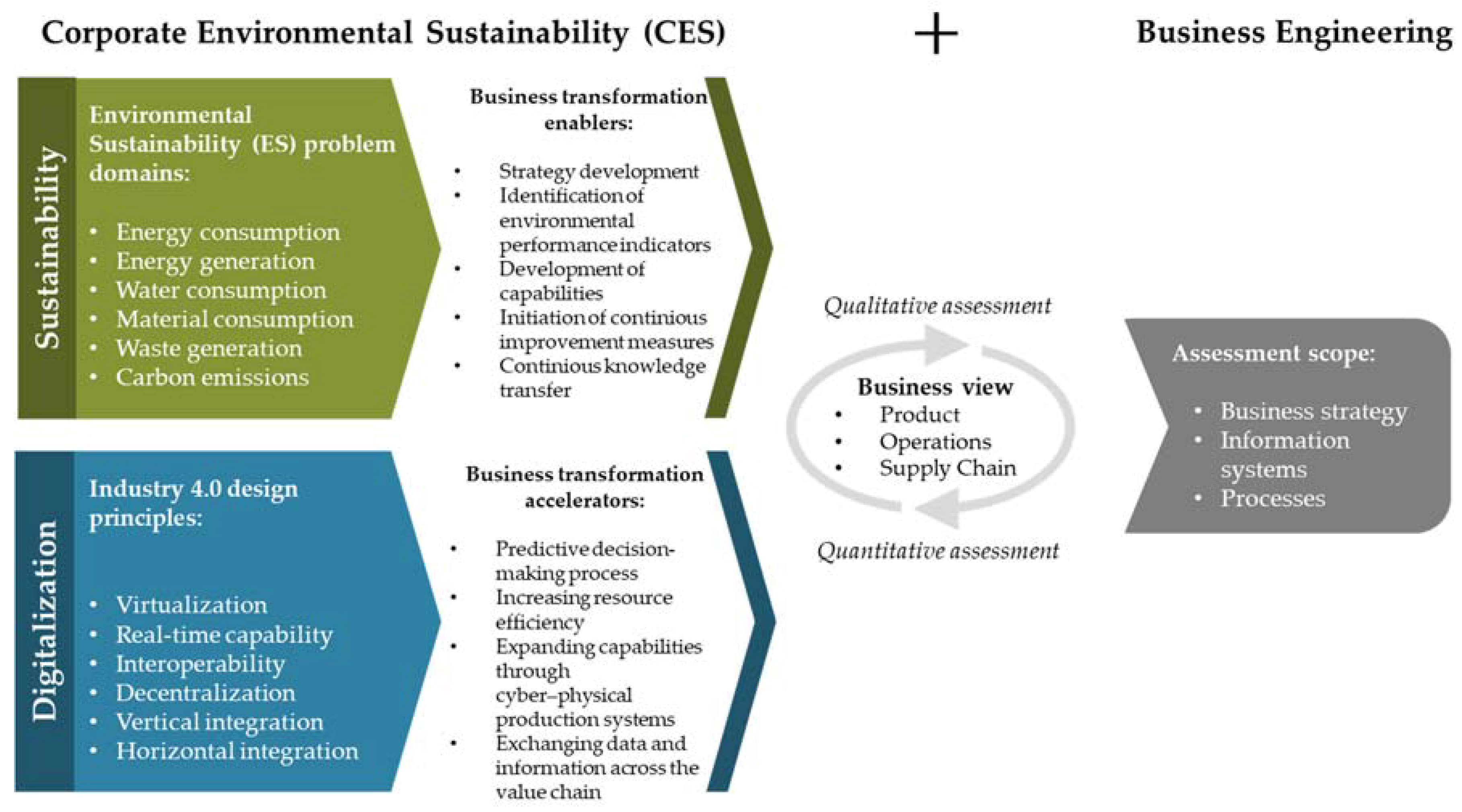
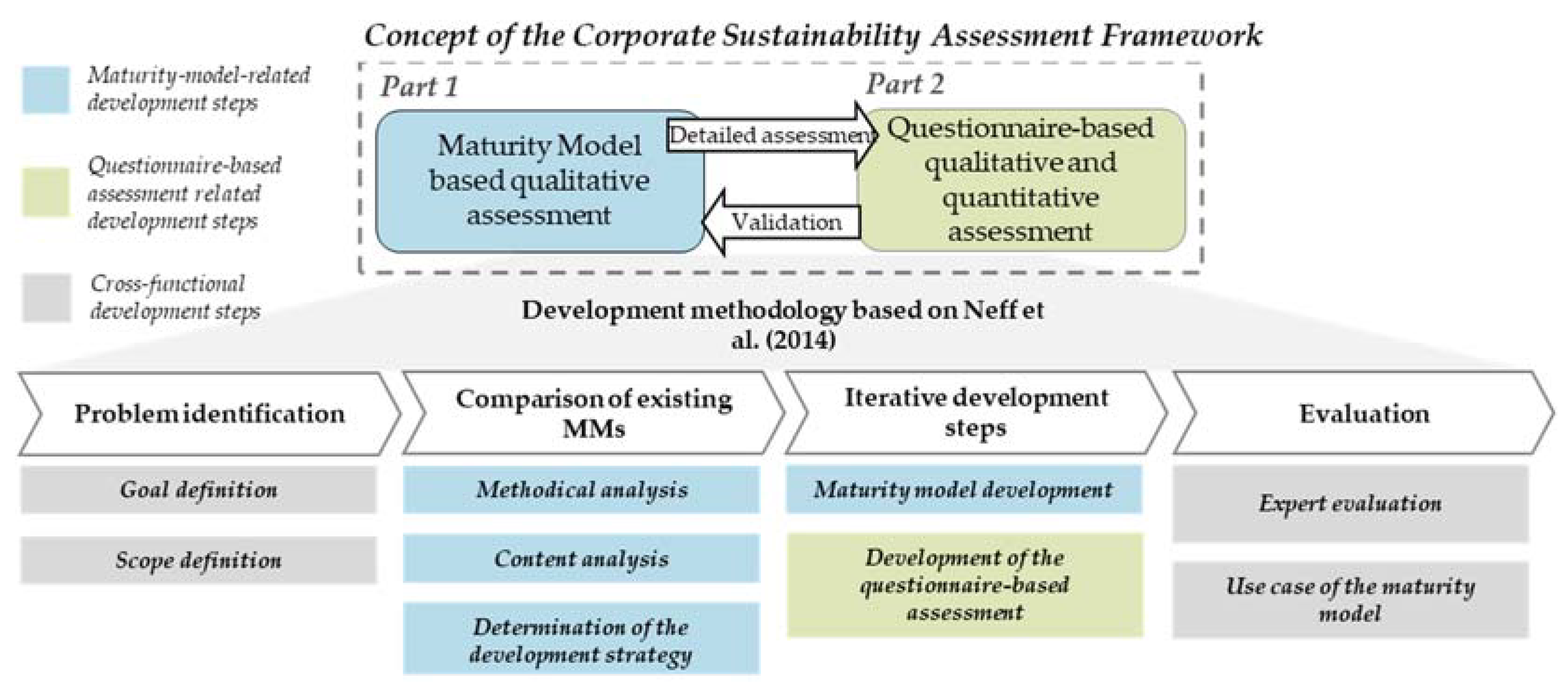
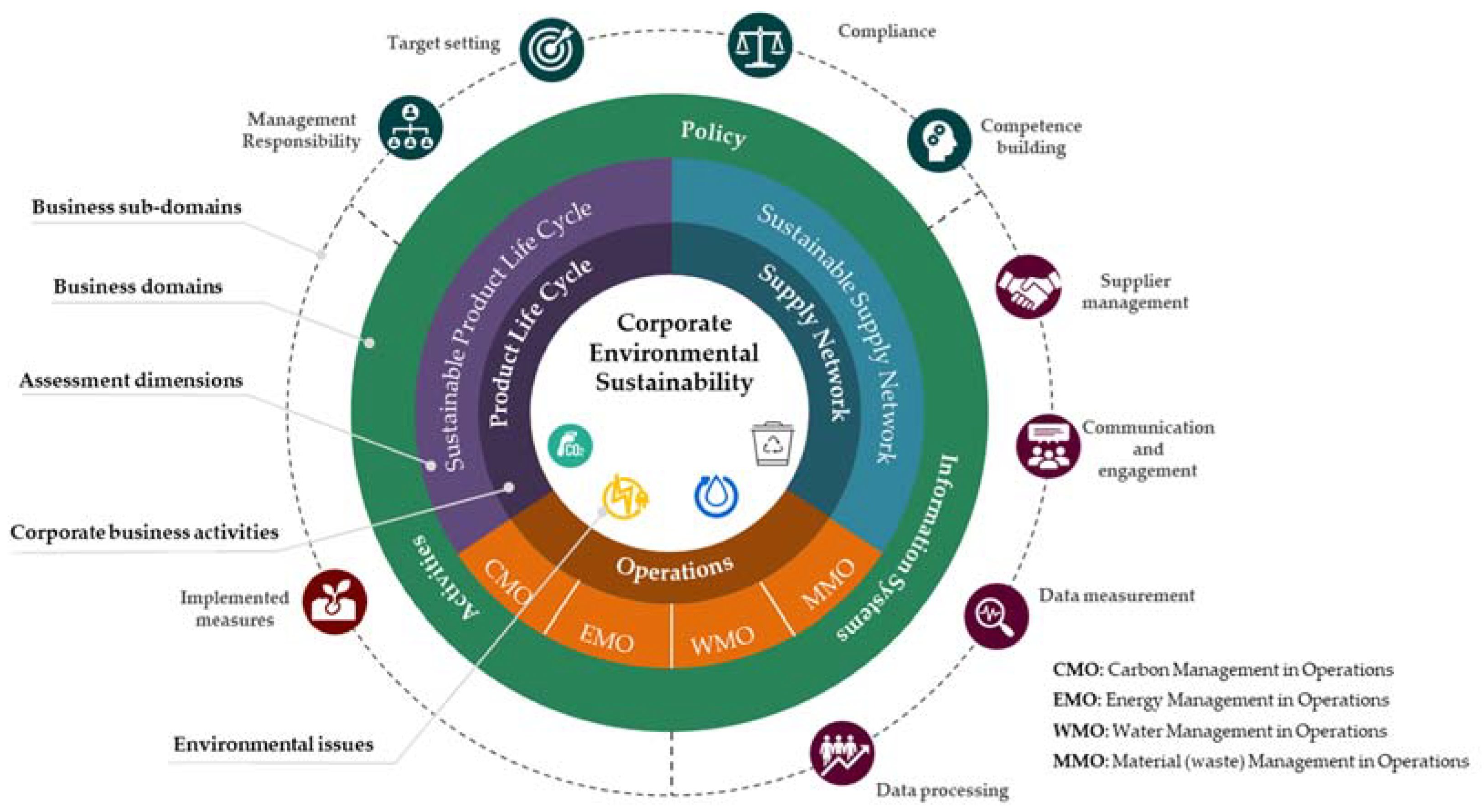
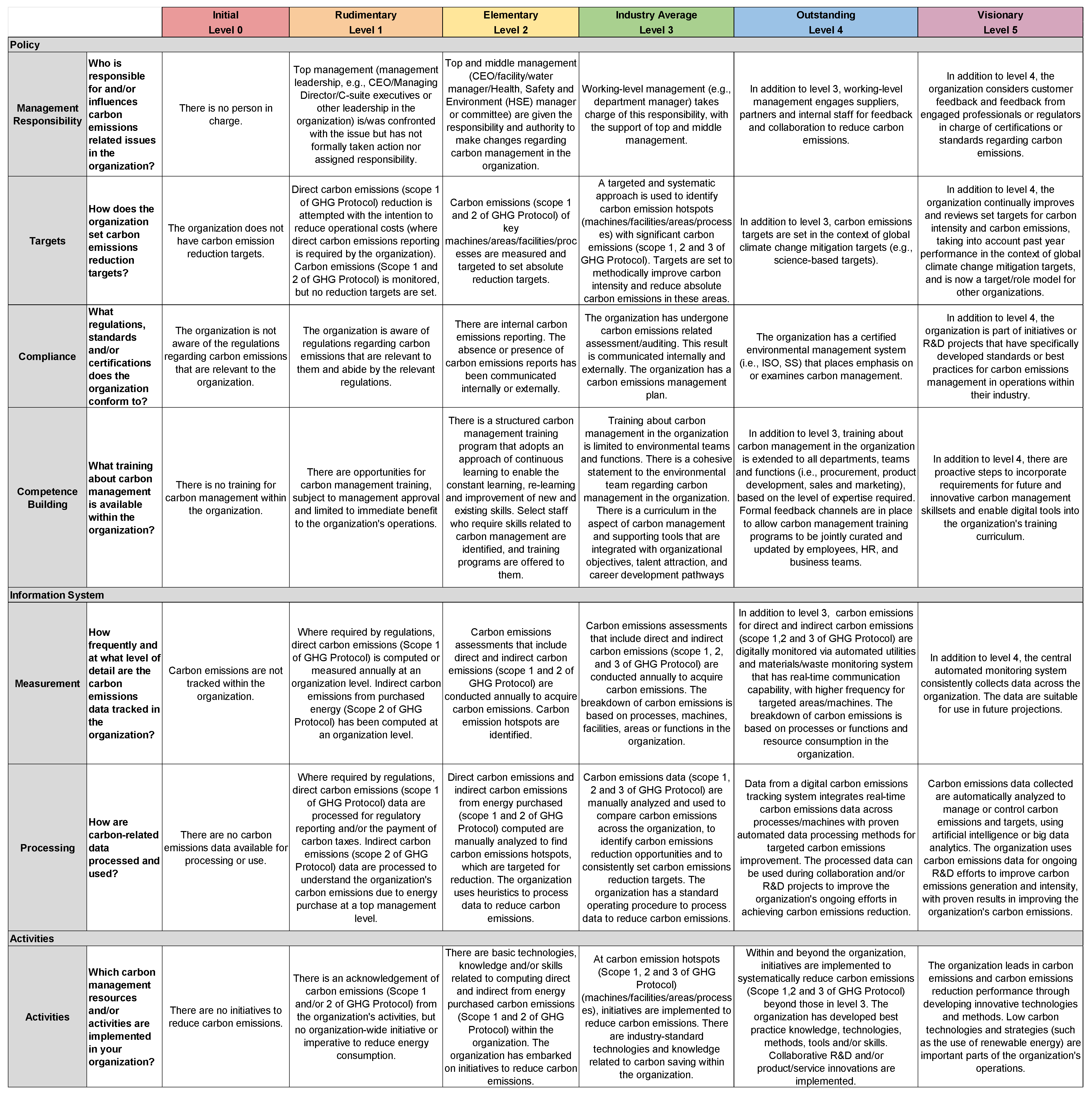
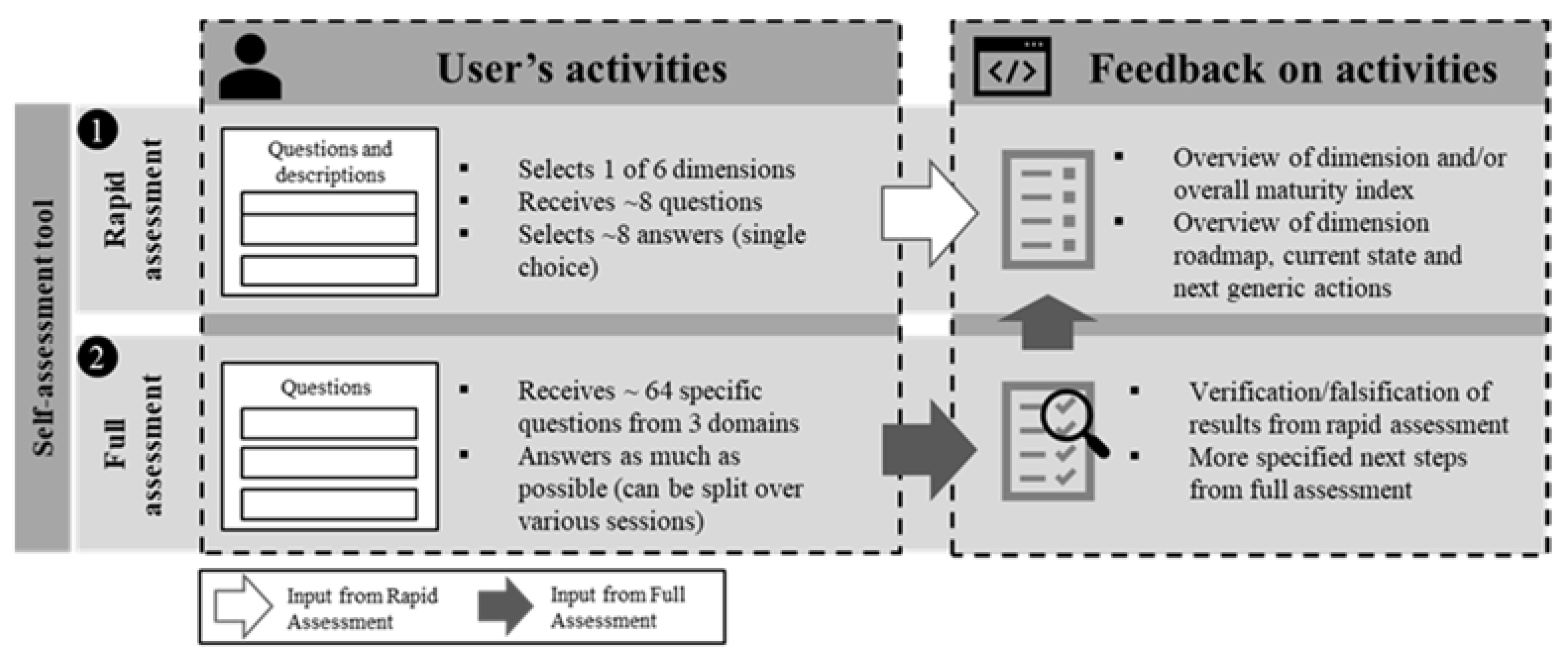
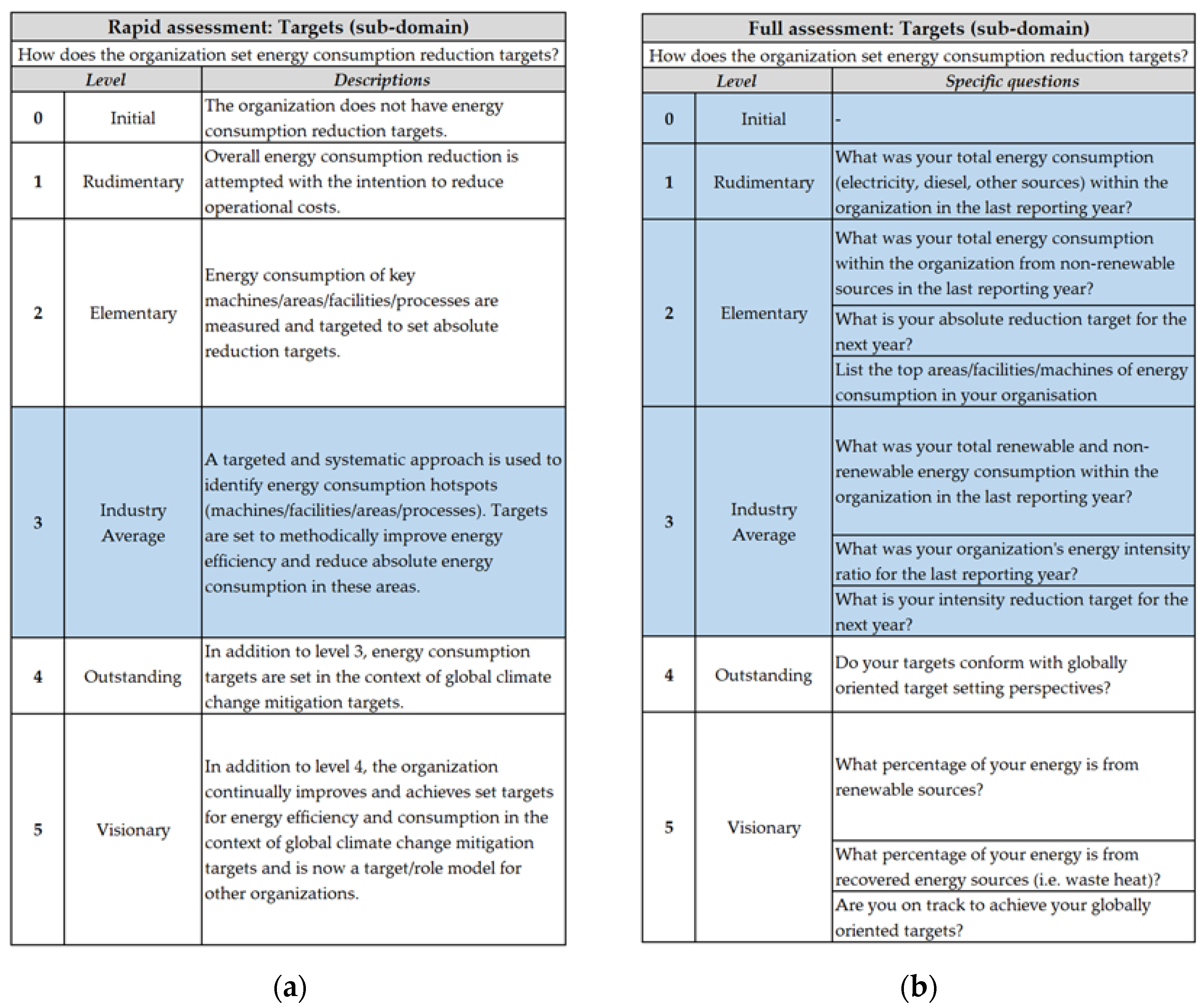
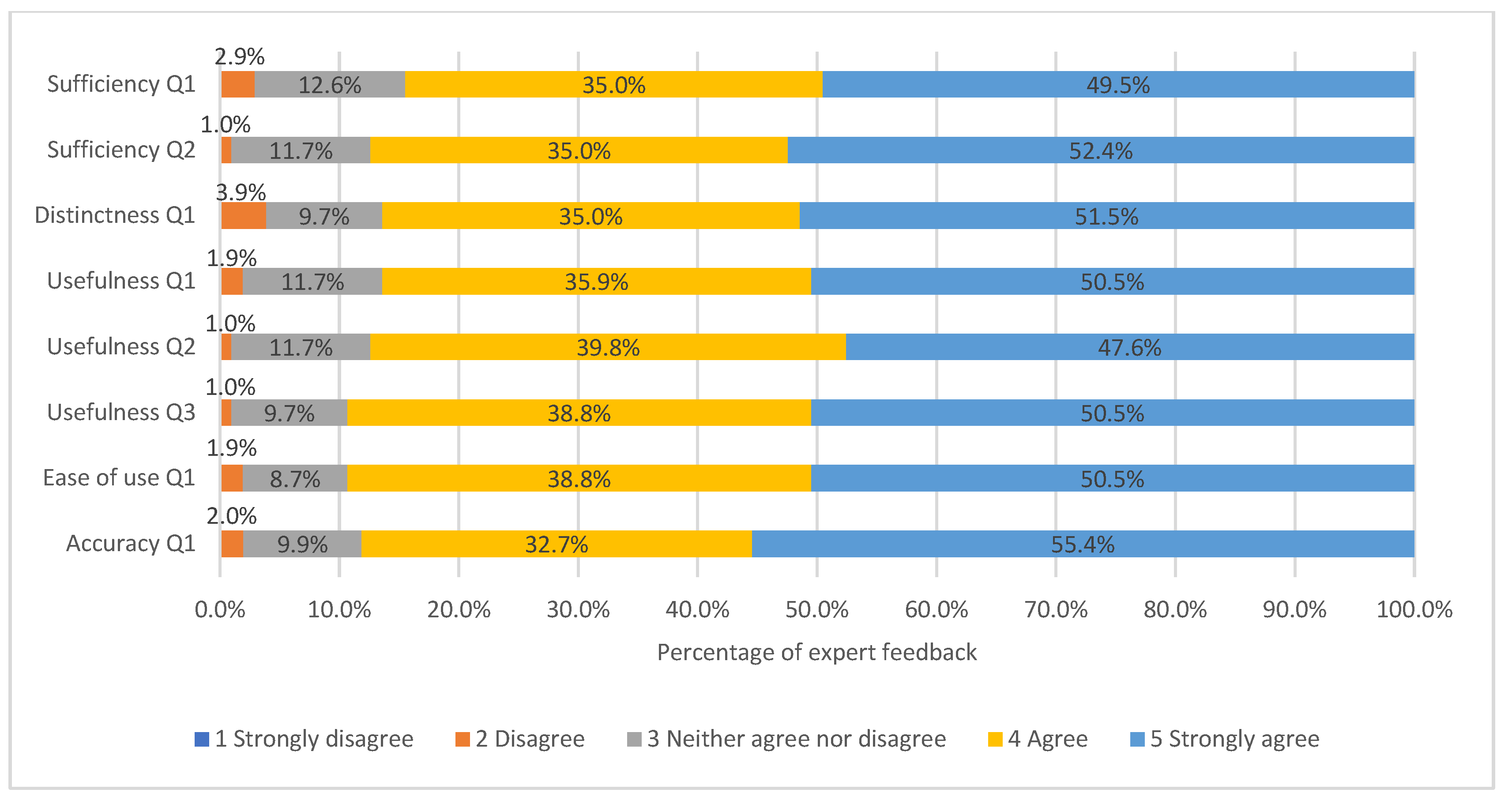
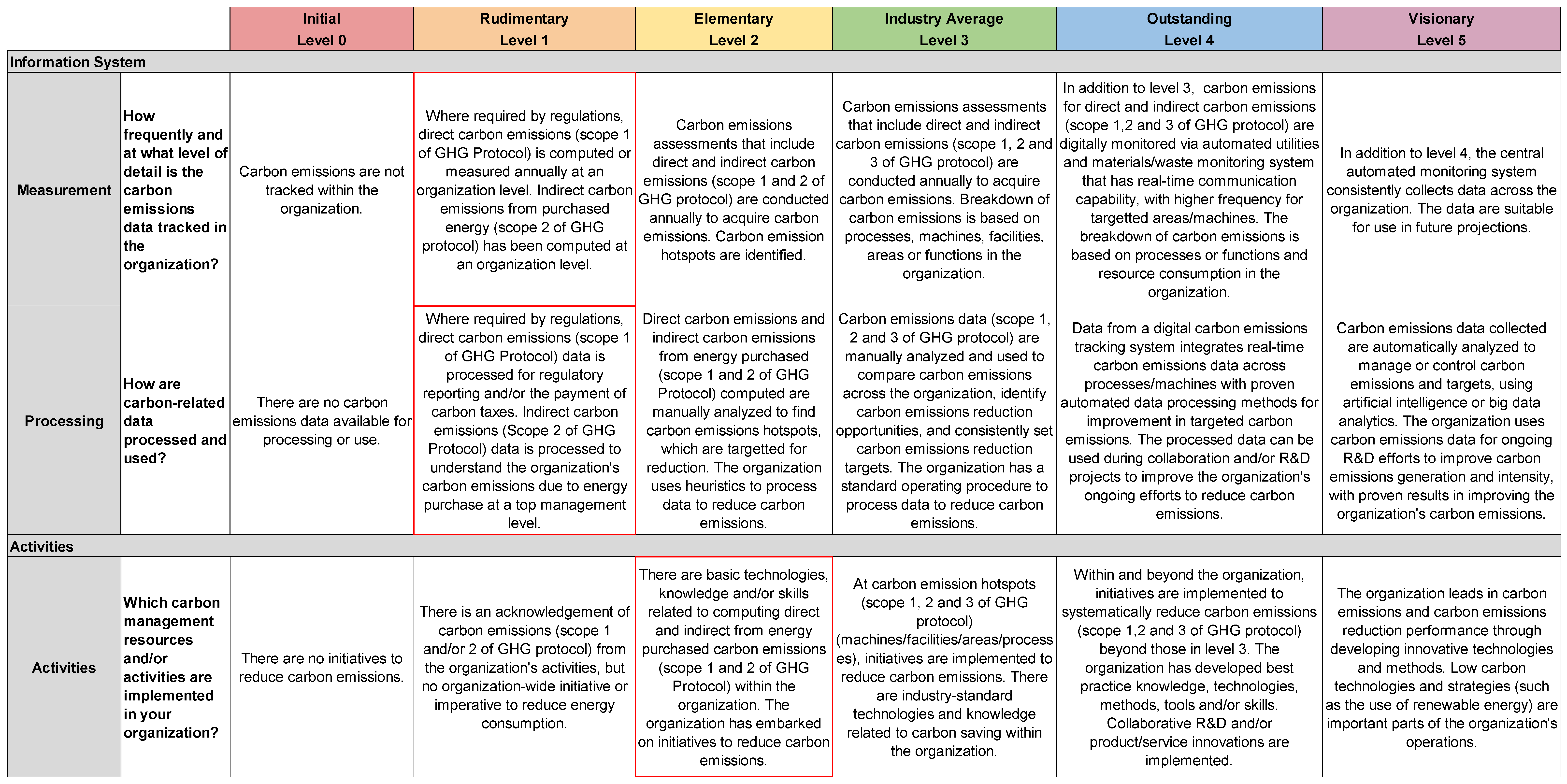
| Business Transformation Enablers | Recommendations for Action |
|---|---|
| Strategy development | Developing a business transformation strategy requires the involvement of various stakeholders, clear target communication, and suitable competencies. |
| Identification of environmental performance indicators | An overview of the most relevant indicators is needed to identify environmental performance indicators. |
| Development of capabilities | By monitoring the most relevant indicators over time, various action fields and their need in capabilities can be identified. This relates especially to monitoring and management of all relevant and required sustainability-related data. |
| Initiation of continuous improvement measures | Business transformation underlies a continuous improvement process and requires continuous analysis of old and new measures |
| Continuous knowledge transfer | To build up competences in the business, it is necessary to build up knowledge, share it, and develop it further. |
| Industry 4.0 Design Principles | Description and Potentials to Support CES |
|---|---|
| Virtualization | Sensor data from the physical world can be converted into information or simulation-based models (e.g., digital twin) and shared across the value chain. This information can enhance processes, products, and decisions to support ES. |
| Real-time capability | Data collection from production processes takes place in real-time and enables real-time monitoring and feedback processes, and could enable manufacturing processes to become more energy- or resource-efficient. |
| Interoperability | Various systems (e.g., machines, products, and workforce) are interconnected to coordinate processes and resources efficiently. |
| Decentralization | The application of digital technologies (CPPS, big data etc.) enables the different systems to make decisions autonomously. By driving continuous knowledge transfer and extending existing capabilities that way, companies’ core competences might shift from collecting ES sustainable data to designing ES sustainable processes. |
| Vertical integration | The integration and automation of operational technology (OT) and information technology (IT) across the production to enterprise levels enhance the operational efficiency of all involved systems. Increasing operational efficiency affects energy and resource efficiency as well. |
| Horizontal integration | Integrating and automating processes with stakeholders along the value chain improves product quality (e.g., productivity) and supports the creation of new business models. Especially, the redesign from linear to circular flows to reduce waste might create sustainable value. |
| Corporate Sustainability | Digitalization | ||||||||||||||
|---|---|---|---|---|---|---|---|---|---|---|---|---|---|---|---|
| Design Principles/Author | Baumgartner and Ebner, 2010 [68] | Cagnin et al., 2013 [69] | Golinska and Kuebler, 2014 [70] | Hynds et al., 2014 [65] | Pigosso et al., 2013 [67] | Finnerty et al., 2017 [71] | Reefke et al., 2010 [72] | Schumacher et al., 2016 [72] | Schuh et al., 2018 [74] | Lichtblau et al., 2015 [74] | Singapore Economic Development Board, 2018 [75] | Temer, 2018 [77] | Geissbauer et al., 2016 [76] | Goal of the Integrative View | |
| Business view | Operations | ■ | ■ | ■ | ■ | (■) | ■ | ■ | ■ | ■ | ■ | ■ | ■ | ||
| Product | ■ | (■) | ■ | ■ | ■ | ■ | ■ | ■ | ■ | ■ | |||||
| Supply Chain | ■ | ■ | (■) | ■ | ■ | ■ | ■ | ■ | ■ | ||||||
| ES problem domains | Carbon | ■ | ■ | (■) | ■ | ■ | |||||||||
| Energy | ■ | (■) | ■ | (■) | ■ | ■ | ■ | ||||||||
| Material and Waste | ■ | (■) | ■ | ■ | ■ | ■ | |||||||||
| Water | ■ | ■ | (■) | ■ | |||||||||||
| Industry 4.0 design principles | Virtualization | (■) | ■ | ■ | ■ | (■) | ■ | ■ | |||||||
| Vertical integration | (■) | ■ | ■ | ■ | (■) | ■ | ■ | ||||||||
| Real-time capability | (■) | ■ | ■ | ■ | (■) | ■ | ■ | ||||||||
| Interoperability | (■) | ■ | ■ | ■ | (■) | ■ | ■ | ||||||||
| Horizontal integration | (■) | ■ | ■ | ■ | (■) | ■ | ■ | ||||||||
| Decentralization | (■) | ■ | ■ | ■ | (■) | ■ | ■ | ||||||||
| Business transformation enablers | Strategy development | ■ | ■ | ■ | ■ | ■ | ■ | ■ | ■ | ■ | ■ | ■ | ■ | ■ | ■ |
| Identification of KPIs | ■ | ||||||||||||||
| Identification of capabilities | ■ | ■ | ■ | ■ | ■ | ■ | ■ | ■ | ■ | ■ | ■ | ■ | ■ | ■ | |
| Identification of needed measures | ■ | ■ | ■ | ■ | ■ | ■ | ■ | ■ | ■ | ■ | ■ | ■ | ■ | ■ | |
| Extension of knowledge | ■ | ||||||||||||||
| Assessment approach | Qualitative | ■ | ■ | ■ | ■ | ■ | ■ | ■ | ■ | ■ | ■ | ■ | ■ | ■ | ■ |
| Quantitative | ■ | ||||||||||||||
| Topic | Question |
|---|---|
| Dimensions |
|
| |
| Maturity levels |
|
| |
| Indicators |
|
| Evaluation Aspects | Expert Feedback |
|---|---|
| Sufficiency |
|
| Distinctness |
|
| Usefulness |
|
| Ease of use |
|
| Accuracy |
|
Publisher’s Note: MDPI stays neutral with regard to jurisdictional claims in published maps and institutional affiliations. |
© 2022 by the authors. Licensee MDPI, Basel, Switzerland. This article is an open access article distributed under the terms and conditions of the Creative Commons Attribution (CC BY) license (https://creativecommons.org/licenses/by/4.0/).
Share and Cite
Eisner, E.; Hsien, C.; Mennenga, M.; Khoo, Z.-Y.; Dönmez, J.; Herrmann, C.; Low, J.S.C. Self-Assessment Framework for Corporate Environmental Sustainability in the Era of Digitalization. Sustainability 2022, 14, 2293. https://doi.org/10.3390/su14042293
Eisner E, Hsien C, Mennenga M, Khoo Z-Y, Dönmez J, Herrmann C, Low JSC. Self-Assessment Framework for Corporate Environmental Sustainability in the Era of Digitalization. Sustainability. 2022; 14(4):2293. https://doi.org/10.3390/su14042293
Chicago/Turabian StyleEisner, Eduard, Cadence Hsien, Mark Mennenga, Zi-Yu Khoo, Jasmin Dönmez, Christoph Herrmann, and Jonathan Sze Choong Low. 2022. "Self-Assessment Framework for Corporate Environmental Sustainability in the Era of Digitalization" Sustainability 14, no. 4: 2293. https://doi.org/10.3390/su14042293
APA StyleEisner, E., Hsien, C., Mennenga, M., Khoo, Z.-Y., Dönmez, J., Herrmann, C., & Low, J. S. C. (2022). Self-Assessment Framework for Corporate Environmental Sustainability in the Era of Digitalization. Sustainability, 14(4), 2293. https://doi.org/10.3390/su14042293






